Emissions of Conventional and Electric Vehicles: A Comparative Sustainability Assessment
Abstract
1. Introduction
- To evaluate and compare the emissions associated with internal combustion engine vehicles (ICEVs) and battery electric vehicles (BEVs), including emissions from power plants used for BEV charging, by modeling power generation and distribution processes.
- To investigate the seasonal and spatial variation in ICEV emissions.
- To identify emissions from both vehicle types and analyze various scenarios to assess their environmental impact.
2. Research Approach
3. Data Collection
3.1. Study Area
3.2. Vehicles’ Emissions Scenarios
3.3. Data Sources and Analysis
3.3.1. General Portfolio for Power Generation
3.3.2. San Antonio Power Plants
3.3.3. Emissions Calculation
- The model uses vehicle characteristics and activity data such as VMT, speed, idle fractions, and driving cycles for each bin to estimate the source hours in each running operating mode.
- Each source bin and operating mode is linked to an emissions rate, and these are multiplied by source hours, adjusted as needed, and summed to estimate the total running emissions. Based on the pollutant and vehicle characteristics, MOVES could adjust the running emissions to take into consideration the local fuel parameters including heating and air conditioning effects, ambient temperature, humidity, and electrical charging losses [46].
4. Results
4.1. Development of Emissions Rates
4.1.1. Scenario A—ICEV-Only Base Case
4.1.2. Scenario B: All Vehicles Are BEVs
4.1.3. The Power Needed for Charging
5. Discussion
6. Conclusions
- SO2 emissions decreased significantly with higher speeds due to the fewer stop-and-go events. PM2.5 emissions were up to 50% higher in rural areas as compared with urban areas. While they were about 45% lower for unrestricted conditions as compared with restricted conditions. CO2 emissions are highly affected by seasonal variations. For instance, rural unrestricted areas showed a 51% decrease from winter to summer. This is due to the high usage of vehicles and air conditioners in summer.
- The results and analysis in this study were developed based on the grid mix used for the selected region in the analysis. It should be noted that this does not necessarily apply to other regions. And this conclusion varies with different grid compositions.
7. Recommendations and Future Research Works
Author Contributions
Funding
Institutional Review Board Statement
Informed Consent Statement
Data Availability Statement
Acknowledgments
Conflicts of Interest
References
- Arora, N.K. Biodiversity conservation for sustainable future. Environ. Sustain. 2018, 1, 109–111. [Google Scholar] [CrossRef]
- Arora, N.K. Environmental Sustainability—Necessary for survival. Environ. Sustain. 2018, 1, 1–2. [Google Scholar] [CrossRef]
- Chapman, L. Transport and climate change: A review. J. Transp. Geogr. 2007, 15, 354–367. [Google Scholar] [CrossRef]
- Li, S. Reduction emissions from transport sector-EU action against climate change. Mordern Appl. Sci. 2009, 3, 56–62. [Google Scholar] [CrossRef][Green Version]
- Chen, G.; Wan, X.; Yang, G.; Zou, X. Traffic-related air pollution and lung cancer: A meta-analysis. Thorac. Cancer 2015, 6, 307–318. [Google Scholar] [CrossRef]
- Sagheb, A.; Alrashydah, E.a.; Vafaeihosseini, E. Valuing traffic emissions’ effect on historic buildings: Environmental assessment to promote historic buildings’ sustainability. J. Cult. Herit. Manag. Sustain. Dev. 2023, 13, 625–641. [Google Scholar] [CrossRef]
- Cubells, J.; Miralles-Guasch, C.; Marquet, O. Traffic pollution as a privilege: An intersectional approach to environmental justice and transport emissions. Transp. Res. Part D Transp. Environ. 2024, 126, 104032. [Google Scholar] [CrossRef]
- Zhong, Z.; Hu, W.; Zhao, X. Rethinking electric vehicle smart charging and greenhouse gas emissions: Renewable energy growth, fuel switching, and efficiency improvement. Appl. Energy 2024, 361, 122904. [Google Scholar] [CrossRef]
- Huang, Y.; Organ, B.; Zhou, J.L.; Surawski, N.C.; Hong, G.; Chan, E.F.; Yam, Y.S. Remote sensing of on-road vehicle emissions: Mechanism, applications and a case study from Hong Kong. Atmos. Environ. 2018, 182, 58–74. [Google Scholar] [CrossRef]
- Zahedi, S.; Batista-Foguet, J.M.; van Wunnik, L. Exploring the public’s willingness to reduce air pollution and greenhouse gas emissions from private road transport in Catalonia. Sci. Total Environ. 2019, 646, 850–861. [Google Scholar] [CrossRef] [PubMed]
- World Health Organization. Ambient (Outdoor) Air Pollution. 2024. Available online: https://www.who.int/news-room/fact-sheets/detail/ambient-(outdoor)-air-quality-and-health (accessed on 13 May 2024).
- Huang, Y.; Surawski, N.C.; Organ, B.; Zhou, J.L.; Tang, O.H.; Chan, E.F. Fuel consumption and emissions performance under real driving: Comparison between hybrid and conventional vehicles. Sci. Total Environ. 2019, 659, 275–282. [Google Scholar] [CrossRef]
- Sun, K.; Tao, L.; Miller, D.J.; Pan, D.; Golston, L.M.; Zondlo, M.A.; Griffin, R.J.; Wallace, H.W.; Leong, Y.J.; Yang, M.M. Vehicle emissions as an important urban ammonia source in the United States and China. Environ. Sci. Technol. 2017, 51, 2472–2481. [Google Scholar] [CrossRef]
- Debbarma, S.; Raparthi, N.; Venkataraman, C.; Phuleria, H.C. Impact of real-world traffic and super-emitters on vehicular emissions under inter-city driving conditions in Maharashtra, India. Atmos. Pollut. Res. 2024, 15, 102058. [Google Scholar] [CrossRef]
- Barth, M.; Boriboonsomsin, K. Energy and emissions impacts of a freeway-based dynamic eco-driving system. Transp. Res. Part D Transp. Environ. 2009, 14, 400–410. [Google Scholar] [CrossRef]
- Singh, V.; Agarwal, A. Variation of PM2. 5 and inhalation dose across transport microenvironments in Delhi. Transp. Res. Part D Transp. Environ. 2024, 127, 104061. [Google Scholar] [CrossRef]
- He, H.-d.; Lu, D.-n.; Zhao, H.-m.; Peng, Z.-r. Characterizing CO2 and NOx emission of vehicles crossing toll stations in highway. Transp. Res. Part D Transp. Environ. 2024, 126, 104024. [Google Scholar] [CrossRef]
- Shancita, I.; Masjuki, H.; Kalam, M.; Fattah, I.R.; Rashed, M.; Rashedul, H. A review on idling reduction strategies to improve fuel economy and reduce exhaust emissions of transport vehicles. Energy Convers. Manag. 2014, 88, 794–807. [Google Scholar] [CrossRef]
- Gan, H.; Sun, L.; Lu, H. Empirical Study of Emission Reduction: Benefits of Park and Ride Strategy. Syst. Eng. 2010, 28, 101–105. [Google Scholar]
- Silva, C.; Ross, M.; Farias, T. Evaluation of energy consumption, emissions and cost of plug-in hybrid vehicles. Energy Convers. Manag. 2009, 50, 1635–1643. [Google Scholar] [CrossRef]
- Reitz, R.D.; Duraisamy, G. Review of high efficiency and clean reactivity controlled compression ignition (RCCI) combustion in internal combustion engines. Prog. Energy Combust. Sci. 2015, 46, 12–71. [Google Scholar] [CrossRef]
- Hao, H.; Liu, Z.; Zhao, F.; Li, W.; Hang, W. Scenario analysis of energy consumption and greenhouse gas emissions from China’s passenger vehicles. Energy 2015, 91, 151–159. [Google Scholar] [CrossRef]
- Hao, H.; Cheng, X.; Liu, Z.; Zhao, F. Electric vehicles for greenhouse gas reduction in China: A cost-effectiveness analysis. Transp. Res. Part D Transp. Environ. 2017, 56, 68–84. [Google Scholar] [CrossRef]
- Dennehy, E.R.; Gallachóir, B.P.Ó. Ex-post decomposition analysis of passenger car energy demand and associated CO2 emissions. Transp. Res. Part D Transp. Environ. 2018, 59, 400–416. [Google Scholar] [CrossRef]
- Greenblatt, J.B.; Saxena, S. Autonomous taxis could greatly reduce greenhouse-gas emissions of US light-duty vehicles. Nat. Clim. Change 2015, 5, 860–863. [Google Scholar] [CrossRef]
- Zhou, X.; Tanvir, S.; Lei, H.; Taylor, J.; Liu, B.; Rouphail, N.M.; Frey, H.C. Integrating a simplified emission estimation model and mesoscopic dynamic traffic simulator to efficiently evaluate emission impacts of traffic management strategies. Transp. Res. Part D Transp. Environ. 2015, 37, 123–136. [Google Scholar] [CrossRef]
- Yang, Y.; Yang, X. Study on travel restriction of urban freight vehicles based on system dynamics. J. Highw. Transp. Res. Dev. 2017, 34, 150–158. [Google Scholar]
- Doucette, R.T.; McCulloch, M.D. Modeling the prospects of plug-in hybrid electric vehicles to reduce CO2 emissions. Appl. Energy 2011, 88, 2315–2323. [Google Scholar] [CrossRef]
- Kim, S.; Shen, S.; Sioutas, C.; Zhu, Y.; Hinds, W.C. Size distribution and diurnal and seasonal trends of ultrafine particles in source and receptor sites of the Los Angeles basin. J. Air Waste Manag. Assoc. 2002, 52, 297–307. [Google Scholar] [CrossRef]
- Hitchins, J.; Morawska, L.; Wolff, R.; Gilbert, D. Concentrations of submicrometre particles from vehicle emissions near a major road. Atmos. Environ. 2000, 34, 51–59. [Google Scholar] [CrossRef]
- Zhu, Y.; Hinds, W.C.; Kim, S.; Sioutas, C. Concentration and size distribution of ultrafine particles near a major highway. J. Air Waste Manag. Assoc. 2002, 52, 1032–1042. [Google Scholar] [CrossRef]
- Zhu, Y.; Hinds, W.C.; Kim, S.; Shen, S.; Sioutas, C. Study of ultrafine particles near a major highway with heavy-duty diesel traffic. Atmos. Environ. 2002, 36, 4323–4335. [Google Scholar] [CrossRef]
- Kittelson, D.B.; Watts, W.F.; Johnson, J.P. Diesel aerosol sampling methodology: State of the art. J. Aerosol Sci. 2004, 35, 1–21. [Google Scholar]
- Onat, N.C.; Kucukvar, M.; Aboushaqrah, N.N.; Jabbar, R. How sustainable is electric mobility? A comprehensive sustainability assessment approach for the case of Qatar. Appl. Energy 2019, 250, 461–477. [Google Scholar] [CrossRef]
- Sullivan, J.; Baker, R.; Boyer, B.; Hammerle, R.; Kenney, T.; Muniz, L.; Wallington, T. CO2 emission benefit of diesel (versus gasoline) powered vehicles. Environ. Sci. Technol. 2004, 38, 3217–3223. [Google Scholar] [CrossRef]
- Saber, A.Y.; Venayagamoorthy, G.K. Plug-in vehicles and renewable energy sources for cost and emission reductions. IEEE Trans. Ind. Electron. 2010, 58, 1229–1238. [Google Scholar] [CrossRef]
- Ji, S.; Cherry, C.R.; Bechle, M.J.; Wu, Y.; Marshall, J.D. Electric vehicles in China: Emissions and health impacts. Environ. Sci. Technol. 2012, 46, 2018–2024. [Google Scholar] [CrossRef] [PubMed]
- Zhong, H.; Chen, K.; Liu, C.; Zhu, M.; Ke, R. Models for predicting vehicle emissions: A comprehensive review. Sci. Total Environ. 2024, 923, 171324. [Google Scholar] [CrossRef] [PubMed]
- Jiang, Y.; Song, G.; Wu, Y.; Lu, H.; Zhai, Z.; Yu, L. Impacts of cold starts and hybrid electric vehicles on on-road vehicle emissions. Transp. Res. Part D Transp. Environ. 2024, 126, 104011. [Google Scholar] [CrossRef]
- Fujita, E.M.; Campbell, D.E.; Zielinska, B.; Chow, J.C.; Lindhjem, C.E.; DenBleyker, A.; Bishop, G.A.; Schuchmann, B.G.; Stedman, D.H.; Lawson, D.R. Comparison of the MOVES2010a, MOBILE6. 2, and EMFAC2007 mobile source emission models with on-road traffic tunnel and remote sensing measurements. J. Air Waste Manag. Assoc. 2012, 62, 1134–1149. [Google Scholar] [CrossRef]
- Tchepel, O.; Costa, A.; Amorim, J.; Miranda, A.; Borrego, C. Transport emission model and dispersion study for Lisbon air quality at local scale. In Proceedings of the 11th International Symposium, Transport and Air Pollution, Graz, Austria, 19–21 July 2002. [Google Scholar]
- Vallamsundar, S.; Lin, J. MOVES versus MOBILE: Comparison of greenhouse gas and criterion pollutant emissions. Transp. Res. Rec. 2011, 2233, 27–35. [Google Scholar] [CrossRef]
- Elkafoury, A.; Negm, A.M.; Bady, M.; Aly, M.H.F. Review of transport emission modeling and monitoring in urban areas—Challenge for developing countries. In Proceedings of the 2014 International Conference on Advanced Logistics and Transport (ICALT), Hammamet, Tunisia, 1–3 May 2014; pp. 23–28. [Google Scholar]
- US Energy Information Administration. State Energy Production Estimates 1960 Through 2023. 2025. Available online: https://www.eia.gov/state/seds/sep_prod/SEDS_Production_Report.pdf (accessed on 1 May 2022).
- EPA. Inventory of U.S. Greenhouse Gas Emissions and Sinks: 1990–2016 (EPA 430-R-18-003); US Environmental Protection Agency: Washington, DC, USA, 2018.
- EPA. Overview of EPA’s Motor Vehicle Emission Simulator (MOVES5) (EPA-420-R-25-005); US Environmental Protection Agency: Washington, DC, USA, 2025.
- The World Bank. Electric Power Transmission and Distribution Losses. 2021. Available online: https://data.worldbank.org/indicator/EG.ELC.LOSS.ZS (accessed on 12 July 2022).
- Weiss, M.; Winbush, T.; Newman, A.; Helmers, E. Energy Consumption of Electric Vehicles in Europe. Sustainability 2024, 16, 7529. [Google Scholar] [CrossRef]

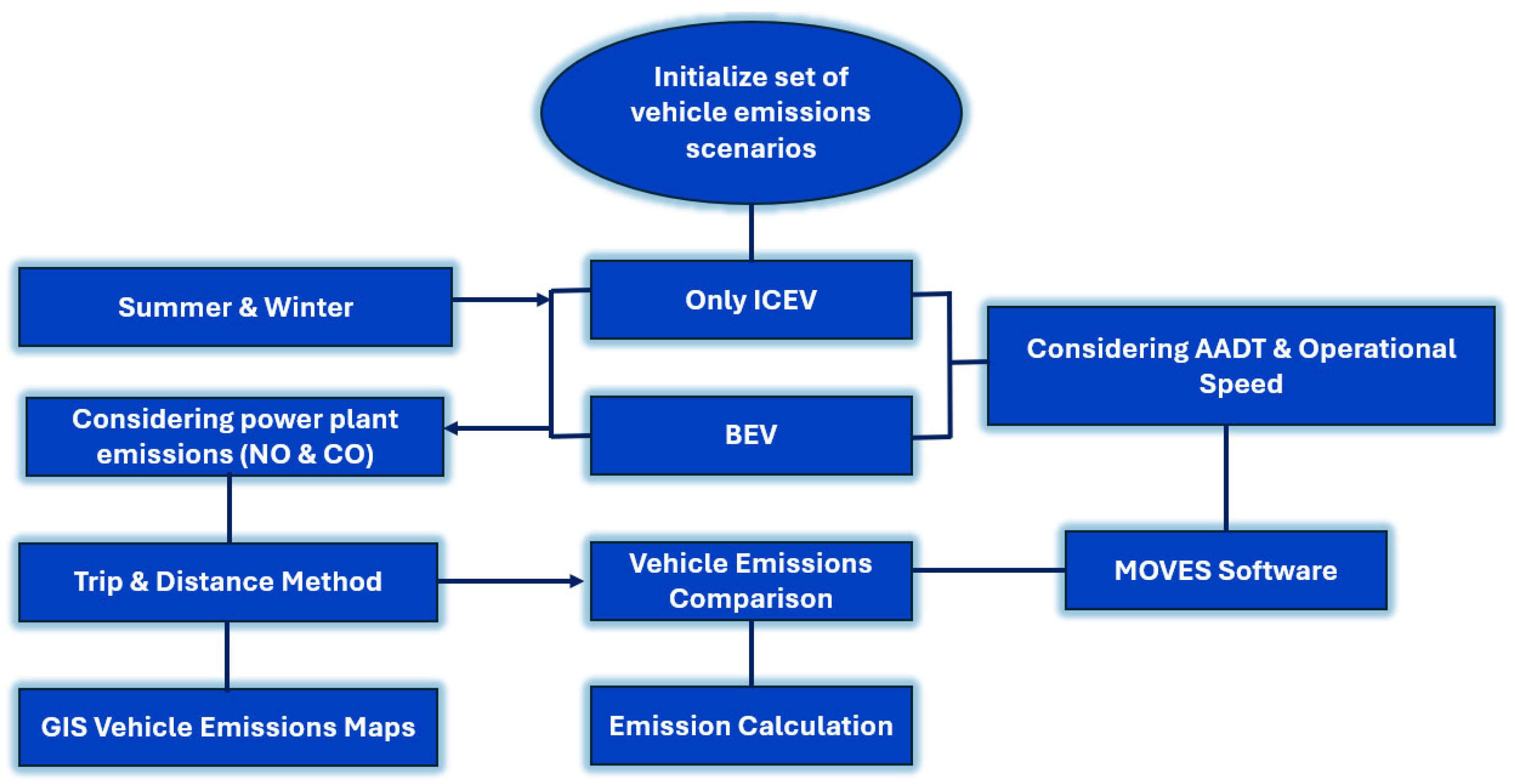
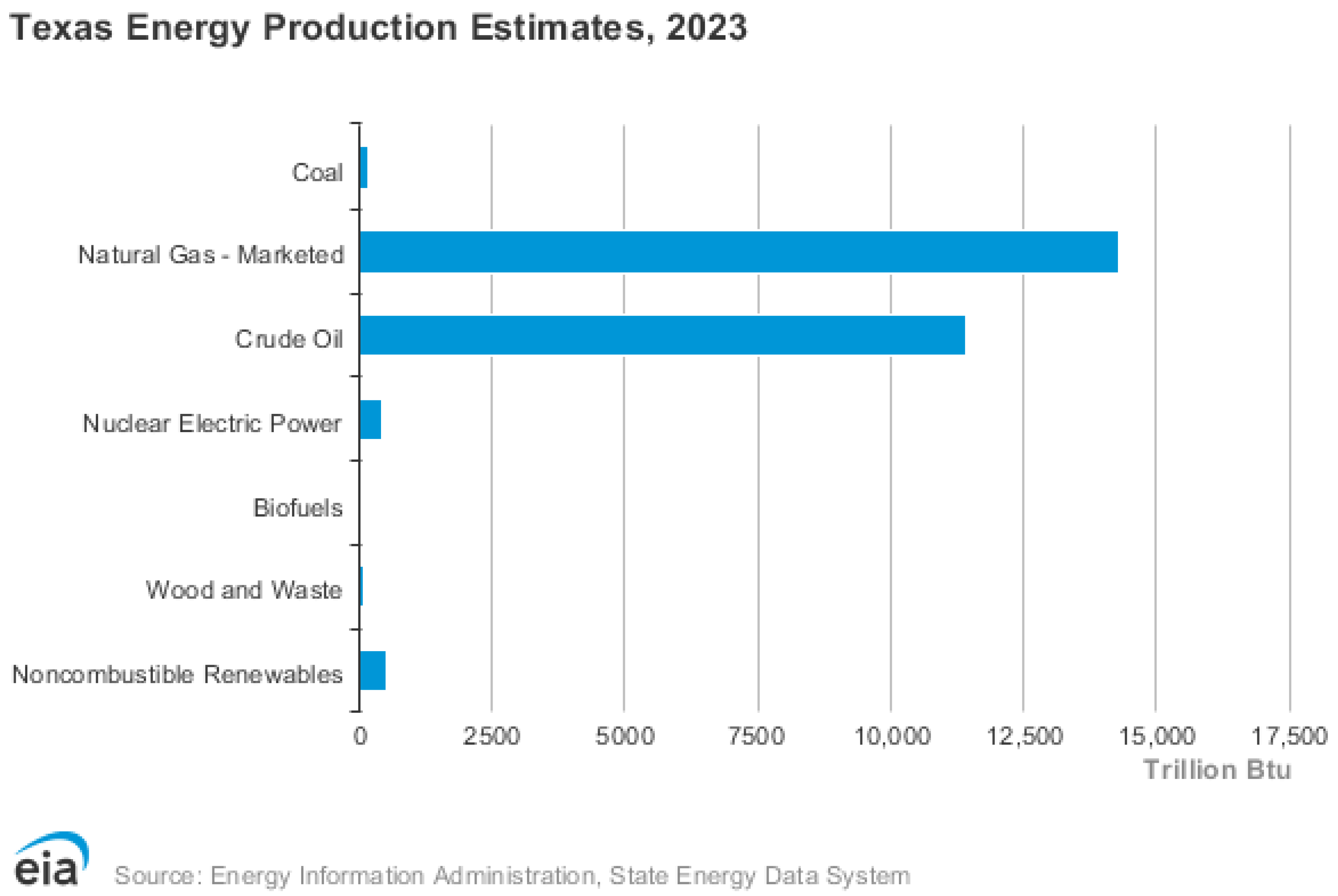
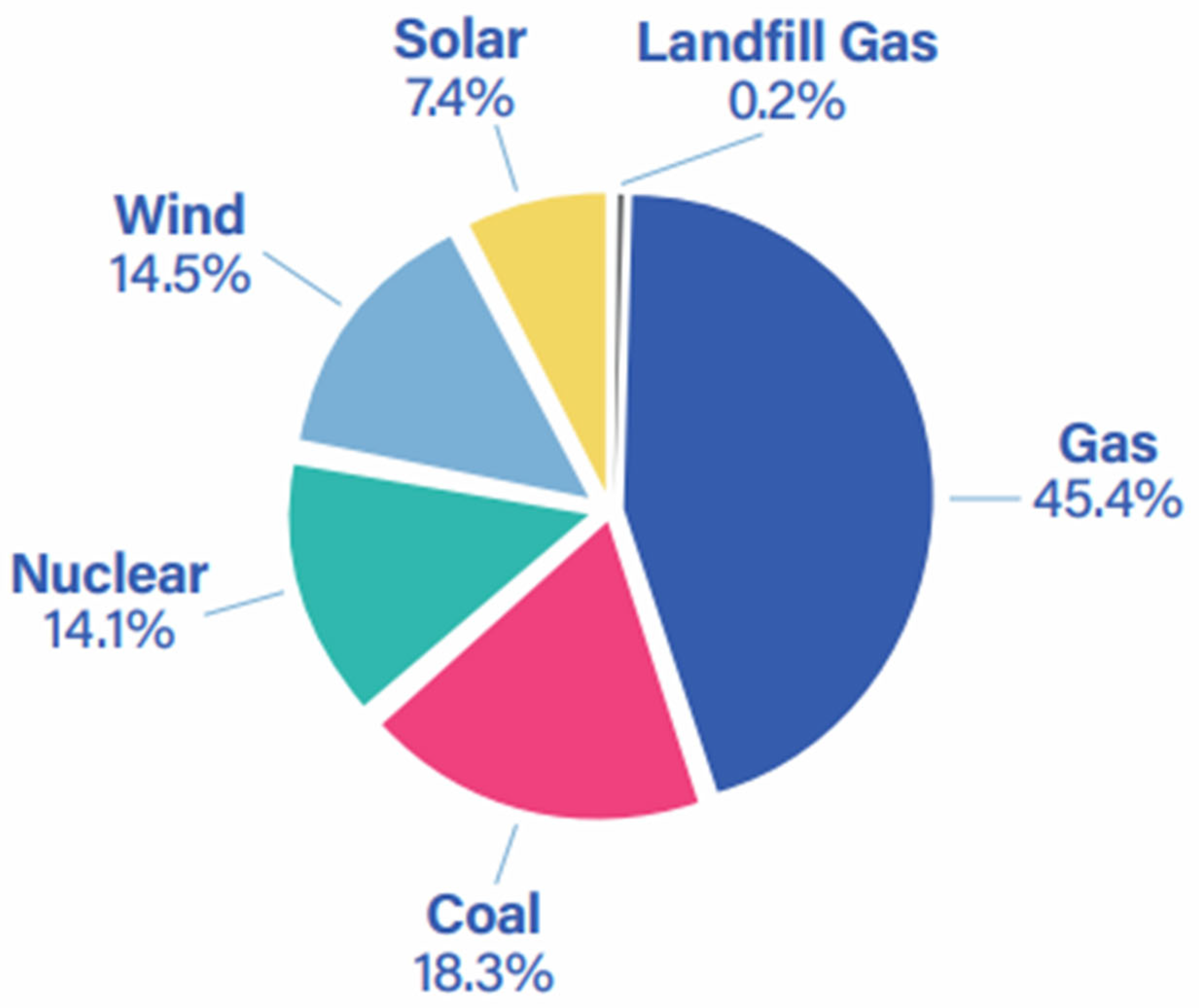

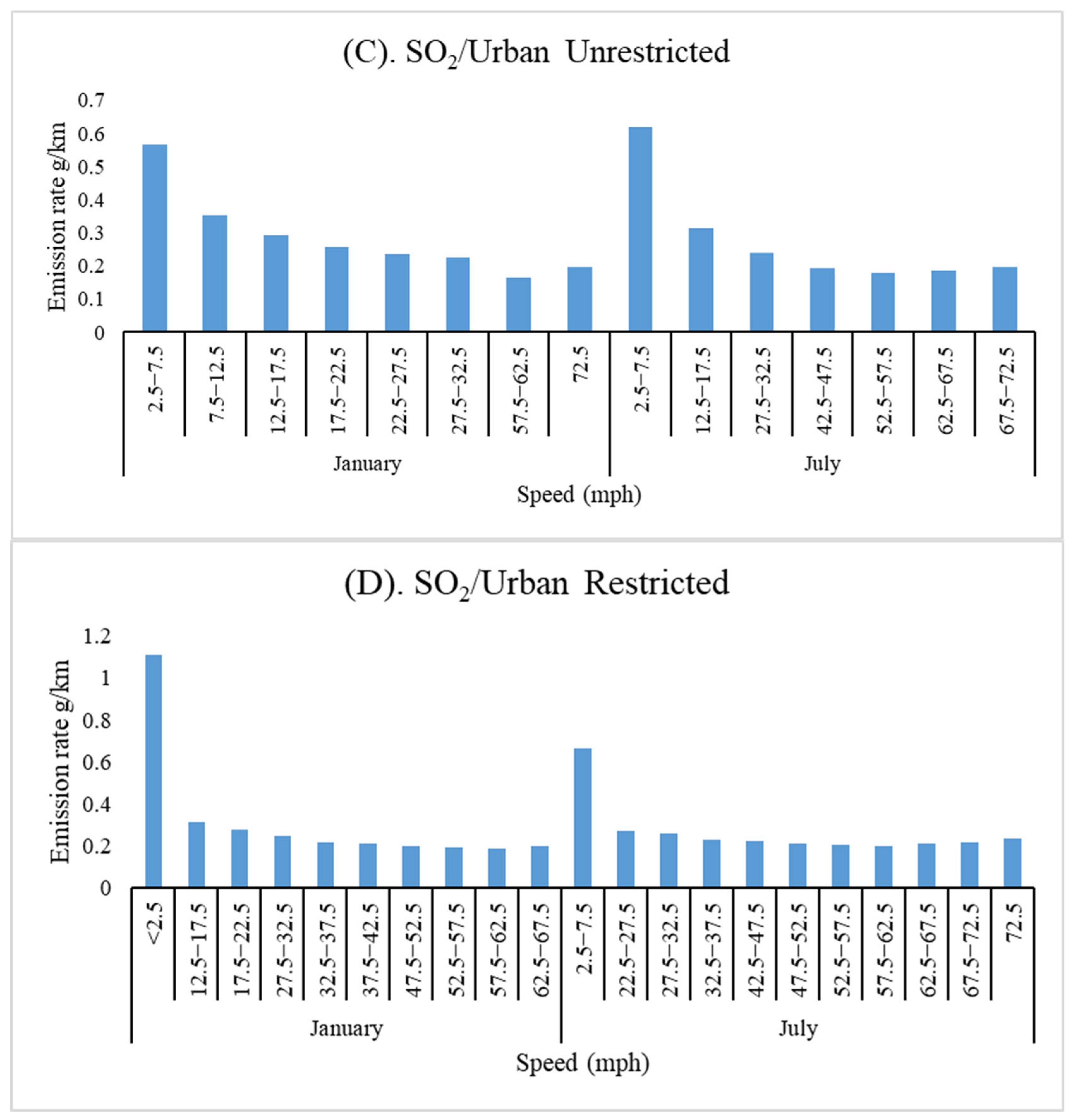
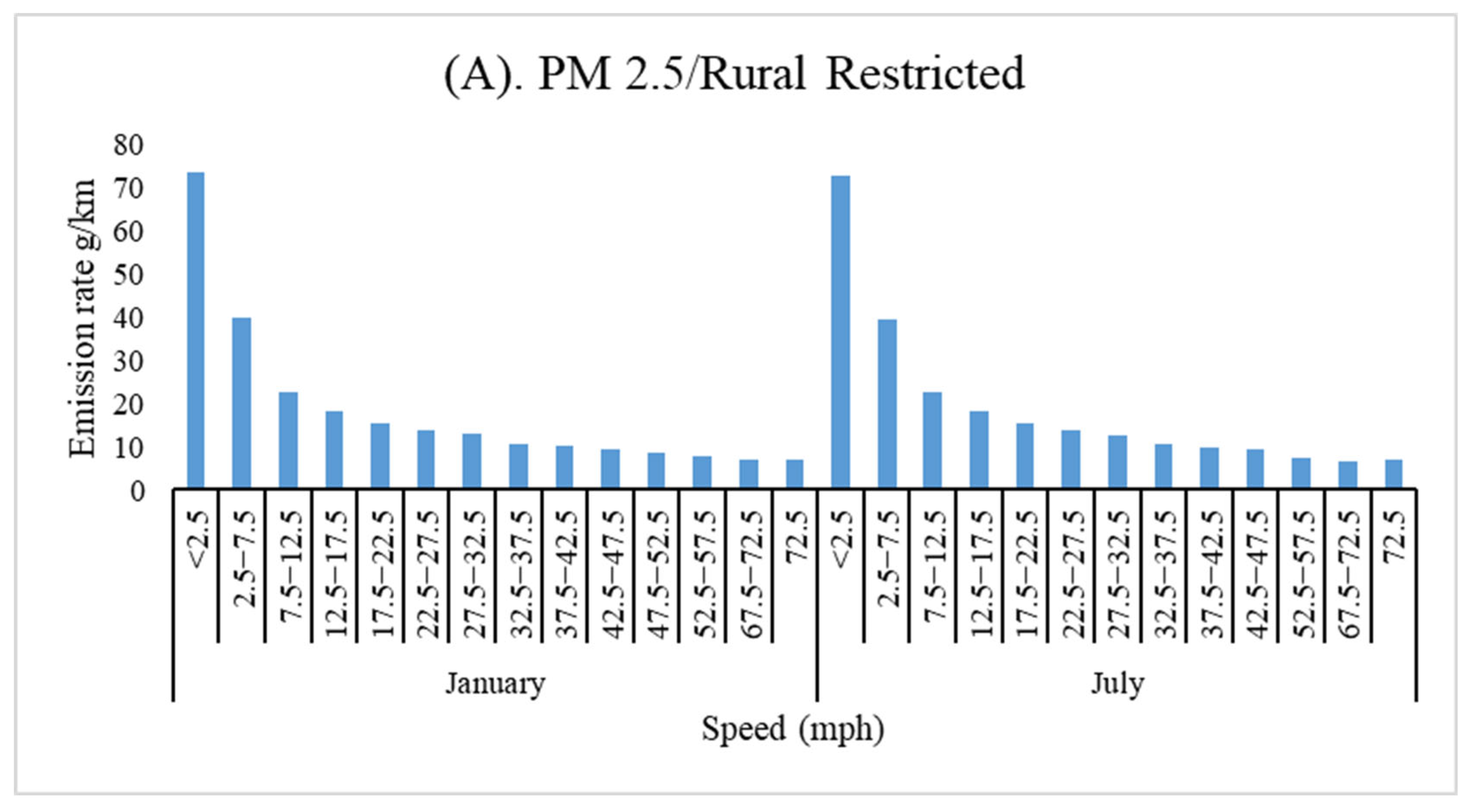

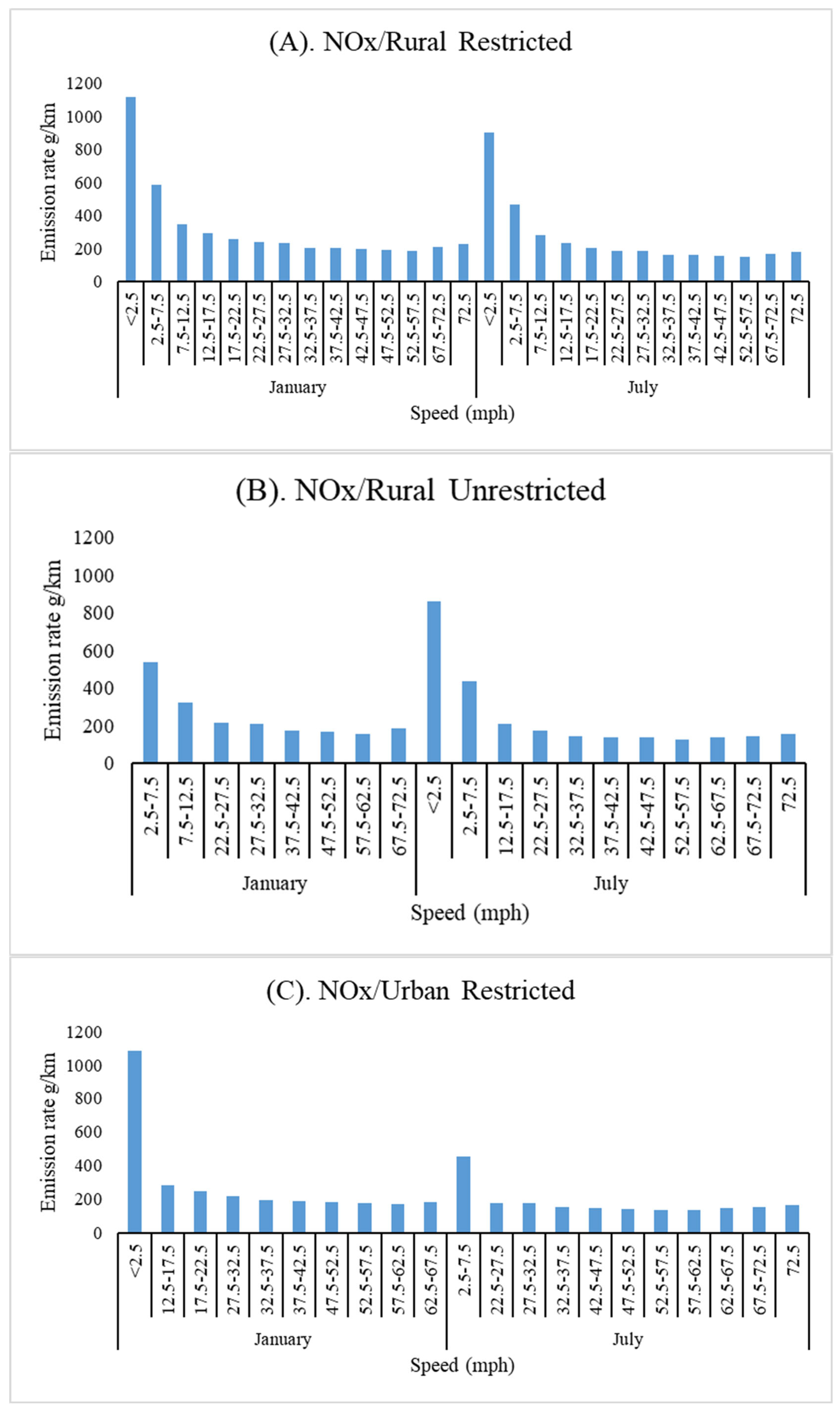


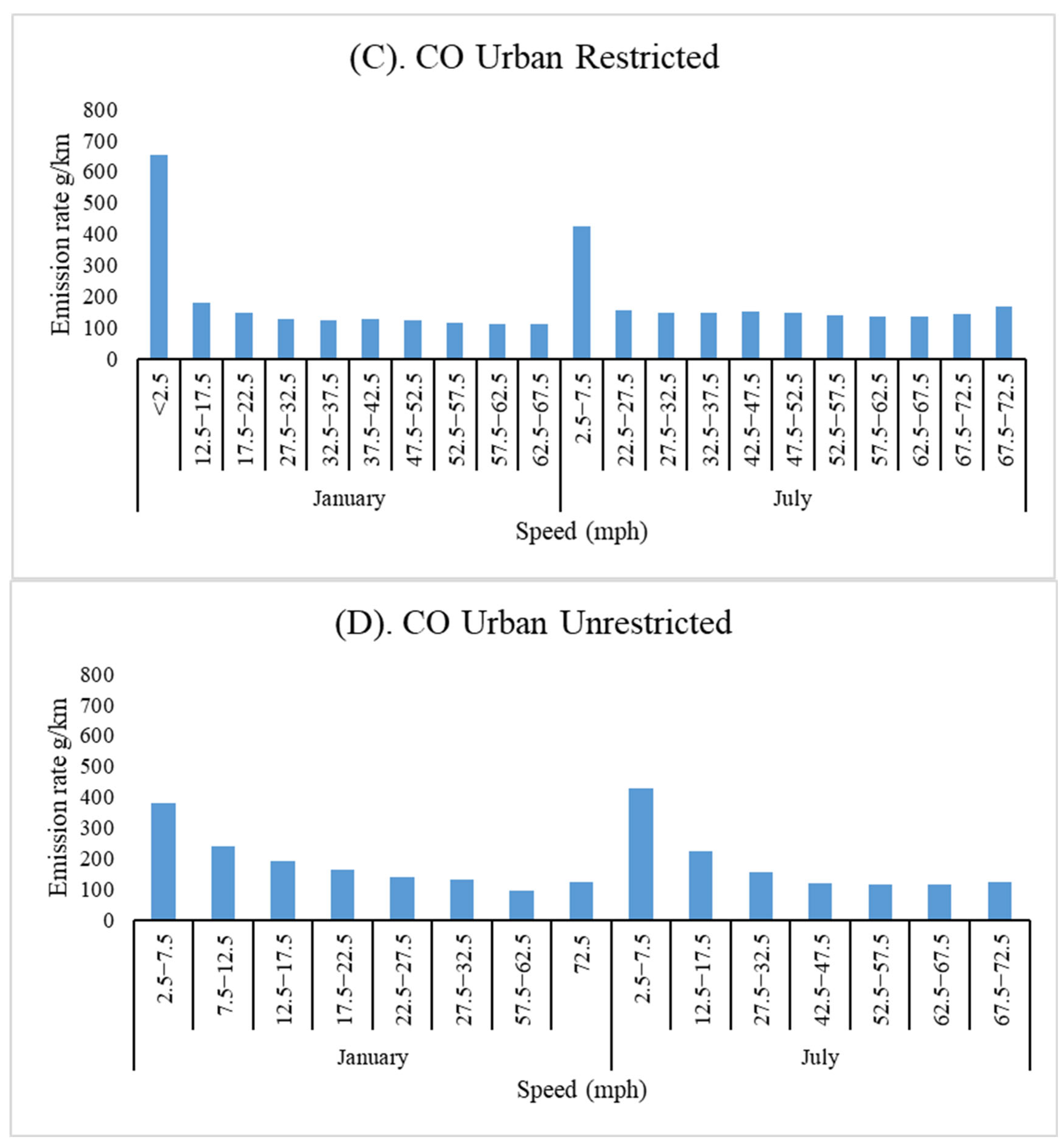
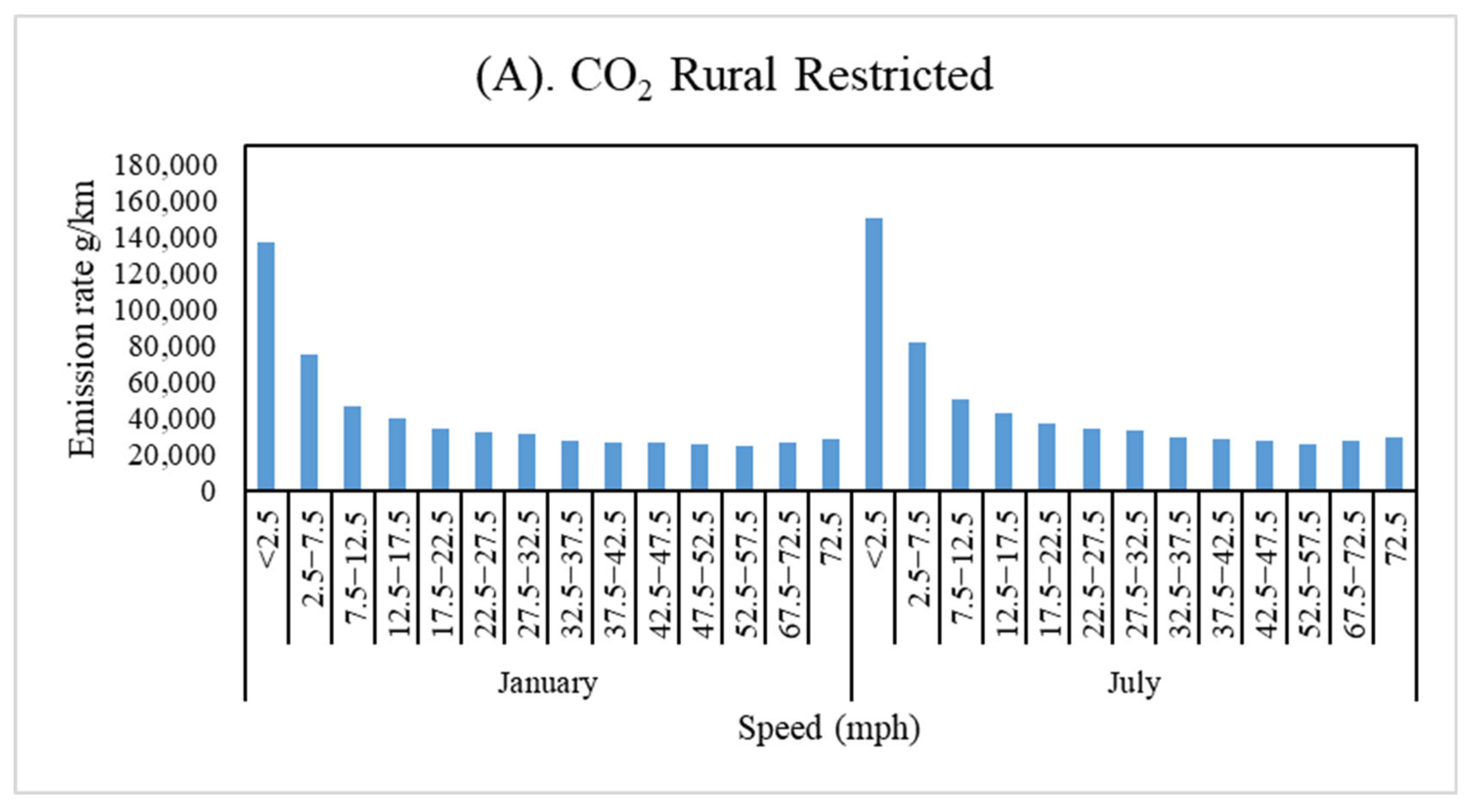
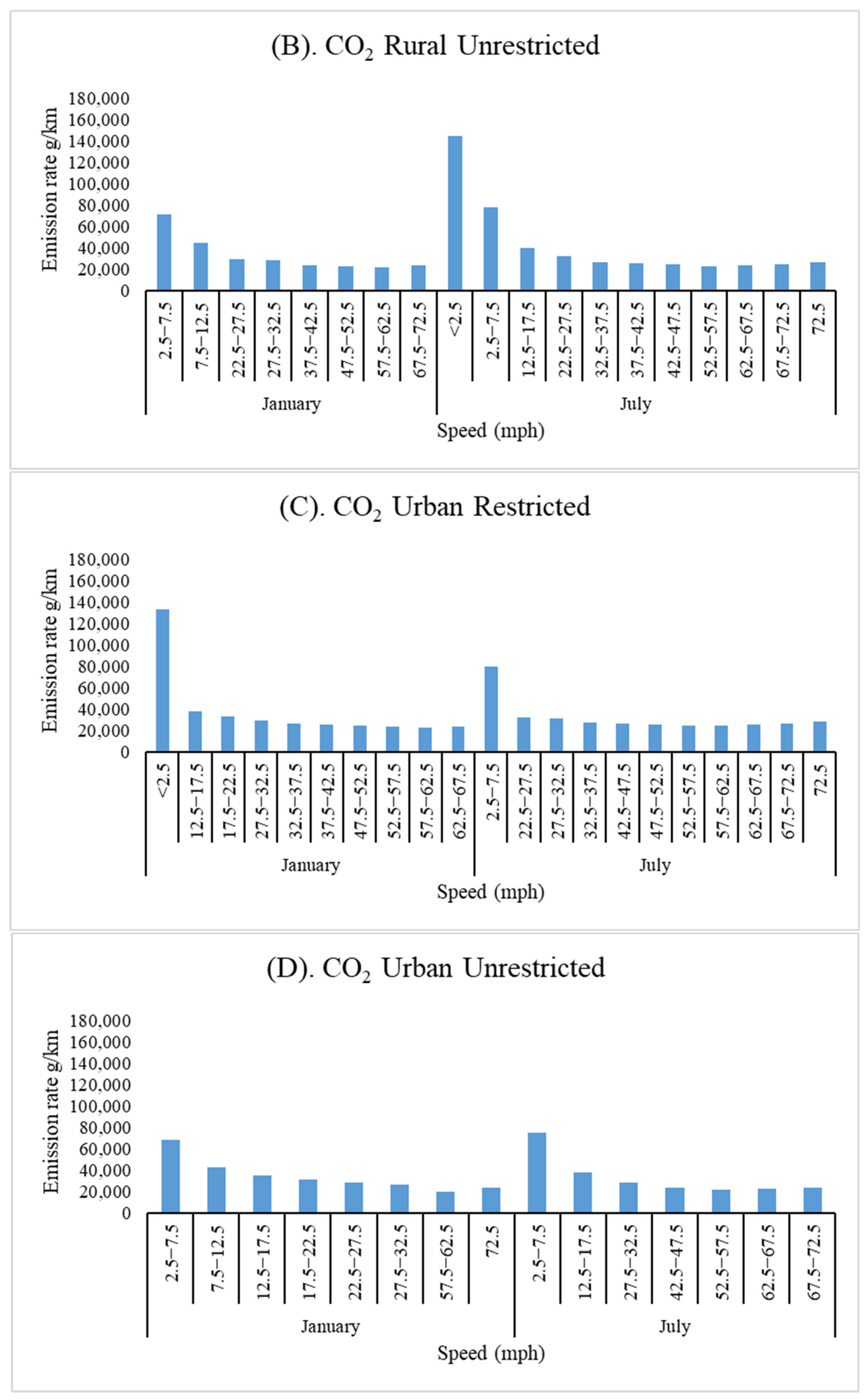


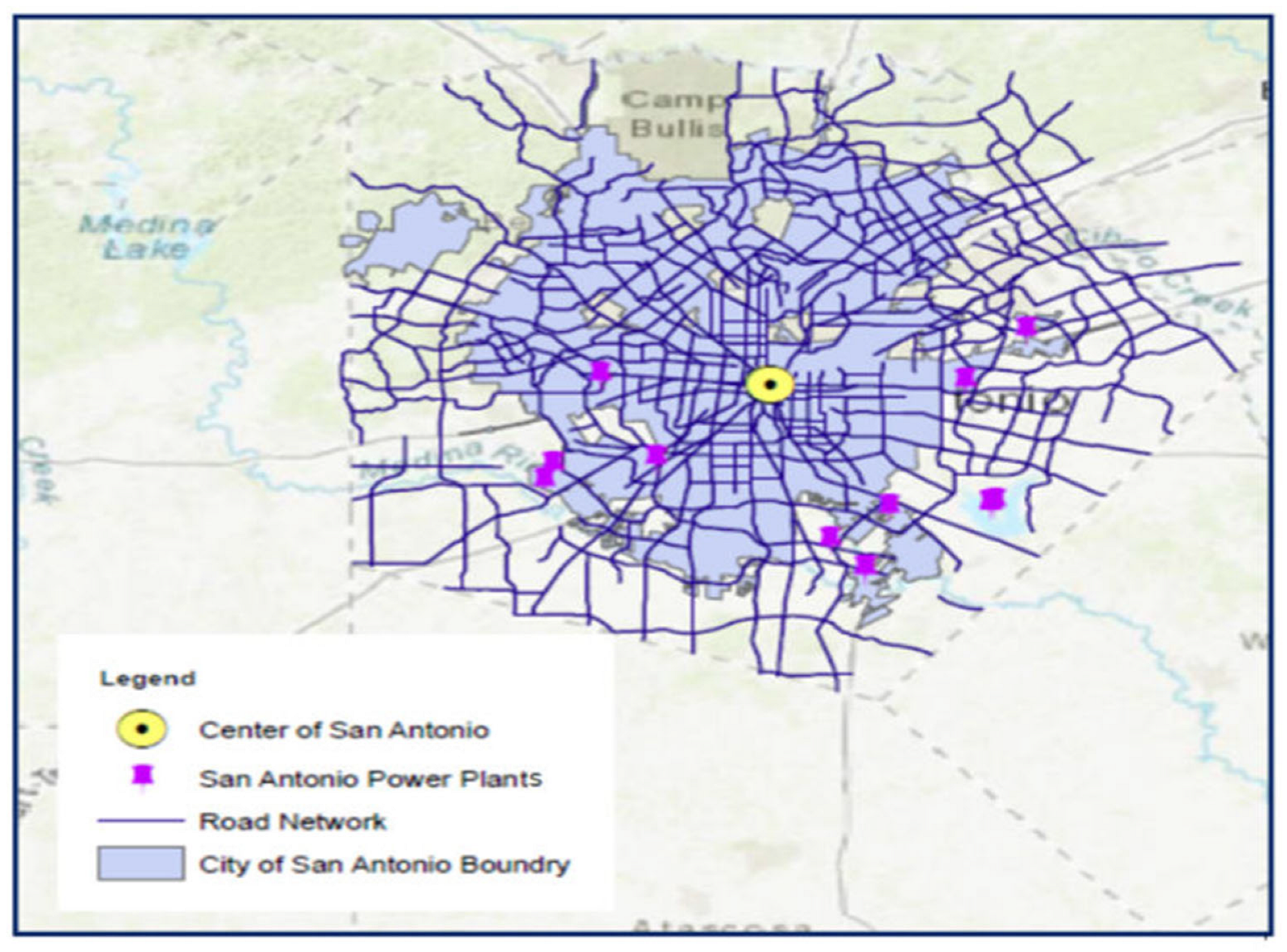
| Scale | National | |
|---|---|---|
| Model | On Road | |
| Type of Calculation | Emission Rate | |
| Time Span | Time aggregate level | Hour |
| Years | 2018 | |
| Months | January and July | |
| Days | Weekdays | |
| Hours | 7:00–8:00 9:00–10:00 | |
| Geographic Bounds | County | Bexar |
| Vehicle/Equipment | Diesel | Passenger trucks; school buses |
| Gasoline | Passenger cars | |
| Roadway Types | Urban | Restricted |
| Urban | Unrestricted | |
| Rural | Restricted | |
| Rural | Unrestricted | |
| Pollutants and Processes | Criteria of Pollutants by EPA | NOx, CO, PM2.5, SO2 |
| Greenhouse Gas | Atmospheric CO2 |
| IH-10 East | IH-10 West | IH-35 North | IH-37 North |
|---|---|---|---|
| E of Loop 1604 | N of Frio St. | N of FM 2252 | S of I-35 |
| W of Loop 1604 | N of Crossroads Blvd. | N of Wiederstein Rd. | N of Cesar Chavez Blvd. |
| E of Foster Rd. | S of Callaghan Rd. | S of FM 3009 | N of Fair Ave. |
| W of Ackerman Rd. | N of Huebner Rd. | Bexar/Guadalupe line | N of Hot Wells Blvd. |
| E of WW White Rd. | S of DeZavala Rd. | S of Loop 1604 | N of SW Military Dr. |
| W of WW White Rd. | N of UTSA Blvd. | N of O’Connor Rd. | N of Loop 410 |
| E of Martin Luther King Jr. Dr. | N of Loop 1604 | S of Thousand Oaks | N of US 181 |
| W of Gevers St. | N of Dominion Dr. | N of Walzem Rd. | - |
| E of Probandt St. | N of FM 3351 | S of Walzem Rd. | - |
| W of Probandt St. | - | S of Rittiman Rd. | - |
| - | - | N of Binz-Engleman Rd. | - |
| - | - | N of Salado Creek | - |
| - | - | W of New Braunfels Ave. | - |
| - | - | N of McCullough Ave. | - |
| Plant Name | Primary Source | Electricity Generation (KWh) | CO2 Emission (Metric Ton) | CO2 Emissivity (g/KWh) | N2O Emissions (Metric Ton) | N2O Emissivity (g/KWh) |
|---|---|---|---|---|---|---|
| Leon Creek * | Natural gas | 121,970 | 121,846 | 998,983 | 67 | 549 |
| O W Sommers * | Natural gas | 580,538 | 580,883 | 1,000,594 | 321 | 552 |
| J T Deely (closed, 2018) * | Coal | 5,433,169 | 5,404,035 | 994,637 | 27,683 | 5122 |
| J K Spruce | Coal | 7,180,500 | 7,142,167 | 994,661 | 36,586 | 5122 |
| Plant Name | Primary Source | Electricity Generation (KWh) | Methane Emissions (Metric Ton) | Methane Emissivity (g/KWh) |
|---|---|---|---|---|
| Tessman Road * | Biomass | 166,633 | 304,173 | 1,825,406 |
| Covel Gardens Gas Recovery | Biomass | 195,944 | 125,380 | 639,876 |
| Nelson Gardens Landfill Gas to Energy * | Biomass | 100,611 | 32,324 | 321,276 |
| Plant Name | Primary Source |
|---|---|
| Blue Wing Solar Energy Generation | Solar |
| SunE CPS2 LLC | Solar |
| SunE CPS1 LLC | Solar |
| OCI Alamo Solar I | Solar |
| OCI Alamo 3 LLC | Solar |
| Type of Emission | Month | Emission Rates for Various Highways (g/km) | Total Emission (g/km) | |||
|---|---|---|---|---|---|---|
| IH-10 East | IH-10 West | IH-35 North | IH-37 North | |||
| CO2 | January | 10,083,381.69 | 16,891,009 | 27,419,982.2 | 8,852,275.25 | 63,246,648.37 |
| July | 10,661,798.82 | 17,859,935 | 28,992,885.8 | 9,360,071.91 | 66,874,691.59 | |
| CO | January | 47,672.78508 | 79,858.274 | 129,637.75 | 41,852.29 | 299,021.0989 |
| July | 57,510.72103 | 96,338.128 | 156,390.286 | 50,489.0866 | 360,728.222 | |
| NOx | January | 77,324.90193 | 129,529.52 | 210,271.464 | 67,884.1024 | 485,009.9927 |
| July | 61,271.66411 | 102,638.21 | 166,617.509 | 53,790.8464 | 384,318.229 | |
| PM 2.5 | January | 3198.171672 | 5357.3641 | 8696.86509 | 2807.69853 | 20,060.09941 |
| July | 3070.294168 | 5143.1522 | 8349.12472 | 2695.43392 | 19,258.00505 | |
| SO2 | January | 84.29901271 | 141.21209 | 229.236331 | 74.0067257 | 528.7541597 |
| July | 89.12825247 | 149.30171 | 242.368599 | 78.246351 | 559.0449132 | |
| Pollutant | Season | Total Emissions for Six Months (g/km) | Total Emissions Estimation for One Year (g/km) |
|---|---|---|---|
| CO2 | Winter | 379,479,890 | 780,728,039 |
| Summer | 401,248,149 | ||
| CO | Winter | 1,794,126 | 3,958,495 |
| Summer | 2,164,369 | ||
| NOx | Winter | 2,910,059 | 5,215,969 |
| Summer | 2,305,909 | ||
| PM 2.5 | Winter | 120,360 | 235,908 |
| Summer | 115,548 | ||
| SO2 | Winter | 3172 | 6526 |
| Summer | 3354 |
| Power Plant Name | Distance (Meters) |
|---|---|
| Leon Creek | 38,597.815 |
| O W Sommers | 68,140.484 |
| JT Deely | 68,140.484 |
| J K Spruce | 68,727.988 |
| Tessman road | 46,584.177 |
| Covel garden gas recovery | 59,804.145 |
| Blue wing solar energy generation | 52,911.679 |
| SunE CPS2 LLC | 69,927.624 |
| SunE CPS1 LLC | 69,927.624 |
| OCI Alamo Solar 1 | 58,224.213 |
| OCI Alamo 3 LLC | 64,113.254 |
| Nelson garden Landfill gas to energy | 64,691.310 |
| Plant Name | Primary Electricity Source | Emissions Calculation | |
|---|---|---|---|
| CO2 (g. m/KWh) | N2O (g. m/KWh) | ||
| Leon Creek | Natural gas | 20,131,431,896 | 11,081,025.1 |
| O W Sommers | Natural gas | 35,597,288,747 | 11,136,091.2 |
| J T Deely (closed, 2018) | Coal | 14,263,269,336 | 103,231,304 |
| J K Spruce | Coal | 14,386,590,251 | 103,228,910 |
| Source | CO2 (g/km) | N2O (g/km) | CO2 Relative to ICEV | N2O Relative to ICEV |
|---|---|---|---|---|
| ICE Vehicles | 780,728,039 | 5,215,969 | 100% | 100% |
| EV (Leon Creek) | 4,026,286.38 | 2,216,205.02 | 0.52% | 42% |
| EV (Sommers) | 7,119,457.75 | 2,227,218.24 | 0.91% | 43% |
| EV (J T Deely) | 2,852,653.87 | 20,646,260.8 | 0.37% | 396% |
| EV (J K Spruce) | 2,877,318.05 | 20,645,782 | 0.37% | 396% |
Disclaimer/Publisher’s Note: The statements, opinions and data contained in all publications are solely those of the individual author(s) and contributor(s) and not of MDPI and/or the editor(s). MDPI and/or the editor(s) disclaim responsibility for any injury to people or property resulting from any ideas, methods, instructions or products referred to in the content. |
© 2025 by the authors. Licensee MDPI, Basel, Switzerland. This article is an open access article distributed under the terms and conditions of the Creative Commons Attribution (CC BY) license (https://creativecommons.org/licenses/by/4.0/).
Share and Cite
Alrashydah, E.; Alqahtani, T.; Al-Sabaeei, A. Emissions of Conventional and Electric Vehicles: A Comparative Sustainability Assessment. Sustainability 2025, 17, 6839. https://doi.org/10.3390/su17156839
Alrashydah E, Alqahtani T, Al-Sabaeei A. Emissions of Conventional and Electric Vehicles: A Comparative Sustainability Assessment. Sustainability. 2025; 17(15):6839. https://doi.org/10.3390/su17156839
Chicago/Turabian StyleAlrashydah, Esra’a, Thaar Alqahtani, and Abdulnaser Al-Sabaeei. 2025. "Emissions of Conventional and Electric Vehicles: A Comparative Sustainability Assessment" Sustainability 17, no. 15: 6839. https://doi.org/10.3390/su17156839
APA StyleAlrashydah, E., Alqahtani, T., & Al-Sabaeei, A. (2025). Emissions of Conventional and Electric Vehicles: A Comparative Sustainability Assessment. Sustainability, 17(15), 6839. https://doi.org/10.3390/su17156839









